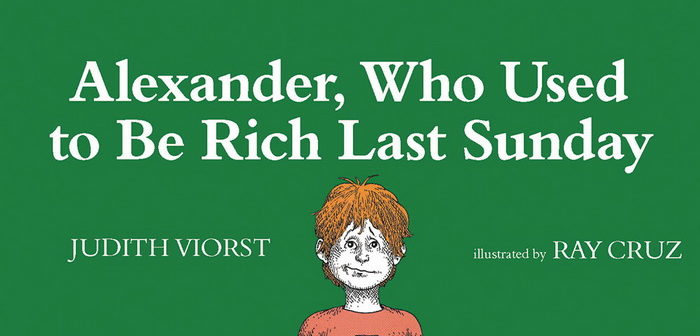While educators agree that money lessons involving currency, addition, and savings are essential, they also remind us that there is more to money than cash and piggy banks.
Lessons in money management taught through trial and error
A story for children with generous grandparents, Alexander, Who Used to Be Rich Last Sunday by Judith Viorst, is a rags to riches story wherein Alexander receives a generous sum from his grandparents, but loses it almost as quickly as he received it.
 Gerard Clyne, Headmaster and Co-founder of Hyde Academy, recommends the skillfully drawn black and white picture book for the “valuable lessons in money management, handling adversity, and dealing with the consequences of one’s actions.” More importantly, the book teaches the value of money using Alexander’s humorous interactions with those around him as he struggles to control his expenditure. Children learn that “impulse buying and instant rewards don’t always provide long-term happiness.” In Alexander’s case, it brings him poverty and a useless pile of junk.
Gerard Clyne, Headmaster and Co-founder of Hyde Academy, recommends the skillfully drawn black and white picture book for the “valuable lessons in money management, handling adversity, and dealing with the consequences of one’s actions.” More importantly, the book teaches the value of money using Alexander’s humorous interactions with those around him as he struggles to control his expenditure. Children learn that “impulse buying and instant rewards don’t always provide long-term happiness.” In Alexander’s case, it brings him poverty and a useless pile of junk.
In the story every child can identify with, Alexander begins with high hopes as he imagines the endless possibilities money can buy him. While “he knows that he should save his money so that he could buy a walkie-talkie at a later date, he gives up his long-term goal for short-term gratification.” In fact, Alexander is punished for each poor financial decision he makes, but each time he fails to recognize how his misfortune is a direct result of his own actions.
As the previous Math and Science Coordinator, Clyne recognizes a great tool for teaching integrated literacy and math when he sees it, and recommends it for teaching money use. Adults can encourage children to keep track of Alexander’s monetary spending by trying “to figure out how much each item costs, the amount of money Alexander has spent as the story moves along, and how much he has at the end of the story.” Children will enjoy keeping track of Alexander’s odd purchases, “from buying chewing gum, a one-eyed teddy bear, and a half-melted candle to rented snakes,” exercising real world math skills while improving their sense of money. As Alexander learns “how far his money can take him and what happens when it’s gone,” children learn the importance of saving money and developing good spending habits.
The ending of the story is foreshadowed in its title, and the story takes children in a full circle from rags to rags, challenging the reader to end the loop. “Every action has its consequences,” reminds Clyne, as he highlights how the story teaches the importance of responsibility and how facing up to one’s consequences is what growing up is all about—profound lessons in money management for children four to eight years old.
The value of money is in using it to help others
The heart-warming narrative of A Chair for my Mother by Vera B. Williams is about how money can be used generously and selflessly. The main character, Rosa, is from a family consisting of only her mother and grandmother, and we learn that they are recovering from the tragedy of losing their home to a fire. Carl Trewin, Assistant Director of Studies at TSL Britain, recommends the uniquely illustrated picture book to children in grade three or higher, while emphasizing how its message of empathy can be appreciated by all ages.
book to children in grade three or higher, while emphasizing how its message of empathy can be appreciated by all ages.
In the story, Rosa’s mother works long days waitressing at a diner as the sole provider of the family, so Rosa and her grandmother help out by pooling their resources and putting all their pennies into the same jar. Their local community bigheartedly come together and raise funds to replace the furniture Rosa and her family had lost along with the rest of their belongings. Meanwhile, children can follow along as Rosa and her family try their best to fill up the coin jar—all the while wondering: will they be able to save enough money to buy Rosa’s grandmother a new armchair?
The story can be used to introduce a non-linear narrative to young readers, and open up a values-based discussion for older readers, says Trewin. “A number of wonderful conversations open up when reading this book with a young person: Why did the community buy new things for Rosa’s family? Why didn’t Rosa’s family have enough money?”
Trewin likes the book for the warm, comforting feelings it incites, the positive familial relationships it models, and the happy ending we all wait for. A Chair for my Mother emphasizes to students that money is not an end in itself but should be used as a means for people to share moments with ones they love.” Not only does the story create positive associations to money, but “it is dripping with examples through which to explore empathy, from the community banding together to replace Rosa’s family’s belongings after a house fire, to Rosa’s concern for the mother and grandmother raising her.” Young readers will especially appreciate how the story reinforces that no person or contribution is too small to make a difference.
This article originally appeared on page 34 of the September 2016 Issue of beijingkids magazine. Click here for your free online copy. To find out how you can obtain a hard copy, contact distribution@truerun.com.
PHOTOS: COURTESY OF HYDE ACADEMY AND TSL BRITAIN




